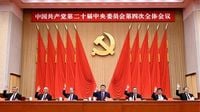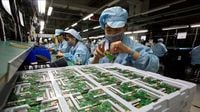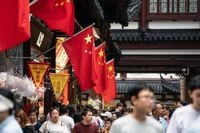Senior officials in Beijing unveiled China’s sweeping blueprint for economic and technological transformation on October 24, 2025, setting the tone for the country’s ambitions from 2026 to 2030. The recommendations, emerging from the fourth plenary session of the 20th Communist Party of China (CPC) Central Committee, outline a future where scientific self-reliance, industrial modernization, and broader economic openness are at the forefront of national policy.
At the heart of the new 15th Five-Year Plan is a drive to build a modernized industrial system and reinforce the bedrock of the real economy, as Zheng Shanjie, head of the National Development and Reform Commission, explained during the press conference. This plan, described as a key period for “basically achieving socialist modernization by 2035,” is intended to mobilize the nation toward what officials call “Chinese modernization.”
“Looking ahead to the next five years, the recommendations propose that Chinese modernization should be underpinned by scientific and technological modernization,” said Minister of Science and Technology Yin Hejun, according to China Daily. The plan’s major objectives include significant advancements in high-quality development and substantial improvements in scientific and technological self-reliance and strength.
To get there, the blueprint calls for upgrading traditional industries while cultivating and expanding emerging and future-focused sectors. Zheng Shanjie highlighted that efforts will target not only the high-quality development of the service sector but also the construction of a modernized infrastructure system. Key industries such as chemicals, machinery, and shipbuilding are set for upgrades, with advanced manufacturing clusters expected to consolidate China’s competitiveness on the global stage.
Strategic and emerging industry clusters—including new energy, new materials, aerospace, and the low-altitude economy—are to be accelerated. The plan also singles out future industries like quantum technology, biomanufacturing, hydrogen and fusion energy, brain-computer interfaces, embodied intelligence, and sixth-generation mobile communications as poised for significant growth. Zheng emphasized, “These industries are ready to take off. It means that in the next 10 years we will build another high-tech industry in China and this will inject continued impetus to our efforts to achieve Chinese modernization,” as reported by Associated Press.
This technological push is not just about shiny new gadgets or headline-grabbing breakthroughs. It’s about deeper self-reliance. China’s leaders are determined to reduce reliance on foreign advanced technology, especially as trade tensions with the United States and other global powers remain elevated. The communique issued after the plenary session didn’t mince words, warning of “rising uncertainties and unforeseen factors.” Han Wenxiu, a senior party official in financial and economic policy, told reporters that China is “well placed to handle such risks in an era when great-power competition is becoming more complex and the international balance of power is undergoing profound adjustments.”
Minister Yin Hejun detailed the four pillars of China’s scientific and technological innovation for the coming years: strengthening original innovation and core technology breakthroughs, integrating scientific and industrial innovation, advancing the coordinated development of education, science, technology, and talent, and boosting the Digital China initiative. “We should prioritize national strategic needs by deploying and implementing a number of major national scientific and technological projects,” Yin said, emphasizing the need for long-term, stable support for basic research.
The plan also calls for the deep integration of scientific and technological innovation with industrial innovation. Enterprises are expected to take the lead in forming innovation consortia and tackling national scientific and technological tasks. Tax deductions for research and development expenses will be increased, and technology-leading enterprises—especially high-tech small and medium-sized businesses—will receive more support.
Digital transformation is another major theme. The Digital China initiative will see the creation of an open, shared, and secure national integrated data market. The so-called “AI Plus” initiative is set to empower all industries and sectors, while the efficient supply of computing power, algorithms, and data will be strengthened. Yin Hejun remarked that this will “comprehensively empower all industries and sectors.”
On the economic front, the CPC’s recommendations reflect a balancing act between external pressures and internal challenges. While the communique signals no major policy shifts, it underscores the intent to remain a global manufacturing power and strengthen domestic economic growth. “The economies of major countries are all driven by domestic demand and the market is the most scarce resource in today’s world,” Zheng Shanjie observed, highlighting the strategic need to expand domestic demand amid a property sector downturn and sluggish consumer confidence.
Government initiatives already in play include investments to modernize factories and subsidies for replacing old appliances and vehicles. Despite these efforts, manufacturing capacity currently exceeds demand in many industries, leading to damaging price wars and a push for greater exports—a dynamic that has exacerbated trade tensions with the U.S. and Europe. Still, China remains the world’s largest manufacturer, accounting for about 30% of global production. The new plan calls for keeping manufacturing at an “appropriate level” with advanced industries as the backbone, according to Associated Press.
China’s outward-facing strategy is also evolving. Commerce Minister Wang Wentao announced that China will “take the initiative to open more broadly in the next five years,” focusing on expanding market access in the services sector—including value-added telecommunications, biotechnology, wholly foreign-owned hospitals, education, and culture. The country plans to accelerate regional and bilateral trade and investment agreements, expand its network of high-standard free trade zones, and enhance trade in intermediate and green goods. Openness in digital trade will be steadily increased, and a transparent, stable, and predictable institutional environment will be fostered to attract foreign investment.
Markets responded positively to the policy readout. On October 24, the CSI 300 Index rose 1.2%, while Chinese shares in Hong Kong climbed 0.7%. Tech-focused indexes saw even stronger gains: the ChiNext Index rallied 3.6% and the STAR 50 Index was up 4.4%. According to Bloomberg, this surge was driven by renewed emphasis on technological self-reliance and the confirmation of a US-China summit.
Yet, political centralization continues apace. The four-day plenum was marked by relatively low attendance, with only 168 of 205 full committee members present—many having been purged in anti-corruption campaigns. The meeting also saw Gen. Zhang Shengmin appointed as China’s second-highest ranking general, replacing He Weidong, who was ousted alongside several other senior officials.
As China enters this new five-year chapter, the interplay of innovation, industry, and international engagement will shape not only its own future, but also the global economic landscape. The country’s leaders are betting that a potent mix of technological self-reliance, industrial modernization, and strategic openness will provide the momentum needed to navigate uncertain times and realize their vision for Chinese modernization.






